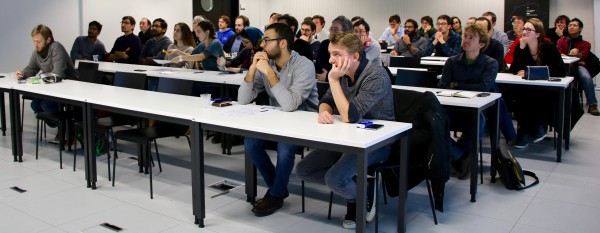MARVEL Junior Seminar — November 2024

Each seminar consists of two presentations of 25 minutes each, allowing to present on a scientific question in depth, followed by time for discussion. The discussion is facilitated and timed by the chair.
Pizzas will be served after the seminars in order to facilitate discussions based on the talks just presented.
Onsite participation
12:15 — Seminars take place in EPFL room Coviz2 (MED 2 1124)
~13:15 — Pizzas will be served in the MED building atrium, second floor
Online participation
Starting at 12:15:
https://epfl.zoom.us/j/68368776745
Password: 1923

Abstracts
Talk 1 — Heisenberg model Hamiltonian from first principles: topological magnons in Mn5Ge3
Flaviano José Marchiori dos Santos
Laboratory of materials simulations (LMS), Paul Scherrer Institut (PSI)
The Heisenberg model is a foundational concept in condensed matter physics that describes how atomic spins interact in a material. This model helps us explain different magnetic properties in materials, such as ferromagnetism and antiferromagnetic. In this seminar, we discuss how to construct model spin Hamiltonian from first principles. As example is given by the study of topological magnons in Mn5Ge3. Topological magnons are collective spin excitations with non-trivial topological properties often characterized by protected edge states and robust transport, hold significant potential for applications in spintronics and quantum information processing. Despite the material's centrosymmetric nature, bulk Mn5Ge3 was identified as an unexpected host for topological magnons induced by the Dzyaloshinskii-Moriya interaction [1]. A distinctive feature of topological physics is the gap opening at the K-point, which can be closed upon the rotation of magnetization. In this study, we explore the robustness of this gap in reduced dimensions by investigating thin films of Mn5Ge3 and examining how the spin-wave spectrum is affected. Our findings clarify the potential applications of topological magnons within Mn5Ge3 for spintronics and magnonics.
[1] M. dos Santos Dias, N. Biniskos, F. J. dos Santos, et al. Nat. Commun. 14, 7321 (2023)
Talk 2 — Exploring the magnetic landscape of easily exfoliable novel 2D materials
Fatemeh Haddadi
Laboratory of theory and simulation of materials (THEOS), EPFL
Magnetic materials can display many self-consistent states in their electronic structure, associated with distinct minima of the energy functional. Finding the global minimum can become challenging, and standard heuristic approaches are not guaranteed to succeed. Here, we apply an automatic workflow to systematically explore the energy landscape and identify the ground-state magnetic order of 180 magnetic monolayers from the Materials Cloud two-dimensional materials database (MC2D). To achieve this goal, we exploit the Robust Occupation Matrix Energy Optimiser (ROMEO) package, which allows us to effectively control and explore the orbital occupation matrices of magnetic ions, rapidly sampling the different local minima in the magnetic energy landscape. We demonstrate the emergence of a rich zoology of self-consistent collinear states, even more so when using Hubbard-corrected energy functionals. We categorize the different monolayers based on their magnetic ordering and discuss the most promising ones for technological applications. Our results identify 96 ferromagnetic, 82 antiferromagnetic, and 2 altermagentic monolayers.
Check the list of the next MARVEL Junior Seminars here.
Low-volume newsletters, targeted to the scientific and industrial communities.
Subscribe to our newsletter